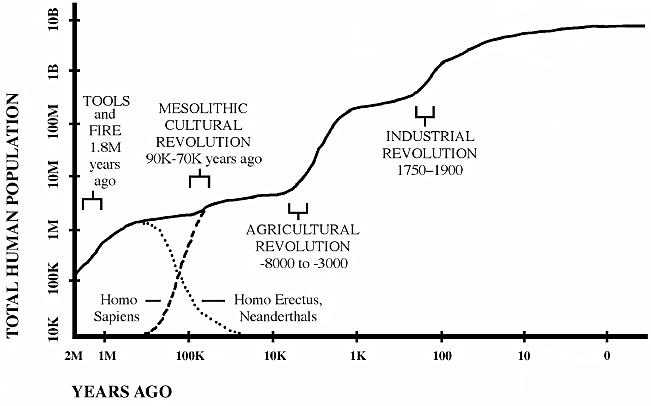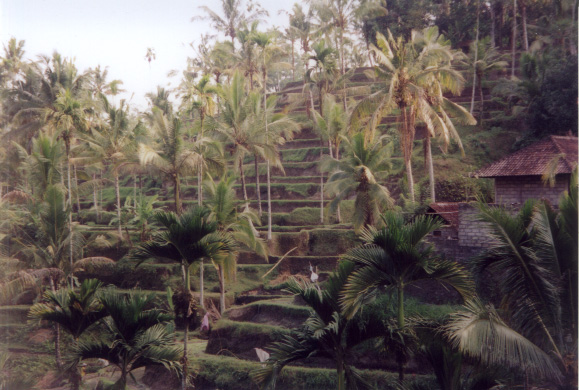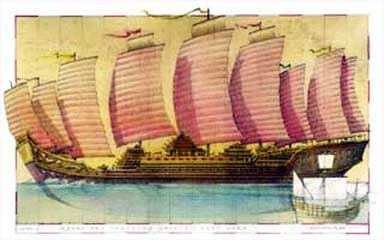The origins of modern technological discovery and inventions
essential dialogue | question | Pacey's Themes | Tool complex example | great titration | explosives | transition | conclusion
Asian cultural hearth:
700-1490 the Chinese supremacy in several key areas of "survival technology" and "fine technology" led to Buddhist, Hindu, and Moslem transfers of several decisive inventions. These included the hydraulic tool complex, equestrian control devices, and warfare inventions such as Greek fire, archery, rockets, and finally gunpowder. These were all examples of fine technologies that altered the world and eventually transformed the west completely.
Survival technology is related to agriculture and transport.
William McNeil is quoted as saying these techniques and associated tools and artifacts "tipped a critical balance in world history."
p. 1.

How many examples of technology based on Pacey's discussion are visible in this print?
Many more than three examples of technology are visible in this print from Diderot's famous 18th century Encyclopedia, published in France.
Weeks 1-2
The Judgment of Thamus: Technophiles vs. Technophobes, Interview 3 to 5 people about the tools they use & to explain technology.
Weeks 3-4-5
Examining the complexity of Technology by explaining the notes you are taking.
Fine Technology | Chinese example | Formula | dialogue | explosives | transition | conclusion
1. Simultaneity of invention
Spinning wheel, Printing, Paper-making,“that the achievements of one society stimulated people elsewhere to make different but related inventions”
2. Stimulus effects -- create new and formidable inventions, such as the canon and transistors.
3. “Transfer of technology” [current SS. Developmental jargon] is a two-way street
Indian textile technology influenced British mechanization “during the industrial revolution.”
“new ways of achieving the same results.”
4. Dialog or conversation, "Such results are like a conversation in which incomplete information sparks new ideas and what we can call 'responsive inventions'."
p.vii
“the interactions”…”are like a conversation."
"Sometimes it is like a dialogue.”
p. vii.
“dialogue or dialectic in which recipients of a new body of knowledge and technique, 'interrogate' it on the basis of their own experience and knowledge of local conditions.
while dialogue or dialectic in technology is the main theme in this book, there are many other themes…such as…machines and their artifacts may carry with them provocative symbolism….The institutions within which technology develops, and the contrasting influences of innovation of…other kinds of organization.
p. x.
essential dialogue | question | Pacey's Themes | Tool complex example | great titration | explosives | transition | conclusion
p. 1
![]()
A tool complex arises simply from
1. body of knowledge gained from practice and useful experiences, and
2. techniques that arise from the use of any tool or especially tool set, or tool complex such as fire and metals, or sluices and water control devices, or gears and wind mills display a particular relationship among materials, practitioners, and culture.
metal smelting trade in luxury goods
Agriculture
(survival technology)
![]()
Hebai and Henan provinces of 10th - 11th century China
"Not only was there iron ore here, but there was also coal....the iron-working district was connected by a canal to populous regions further south, in including Kaifeng, then the capital...."
p. 2.
“…with stimulus to invent and improve techniques stemming from exchange of artifacts & ideas.
“Chinese iron industry, which manufactured weapons and farm tools, and developed specialized qualities if iron for … cast iron for (white “cast iron”) for bells and plow shares… the earliest of these bells dates from 1079,…chiefly at foundries in Shanxi Province.”
Pp 1-2.
Technophile – people who display a fondness for technical inventions, gadgets and tools, Theuth or Thoth.
versus
Technophobe – those who express concern, even undue scorn for the latest technical advances, Thamus.
essential dialogue | question | Pacey's Themes | Tool complex example | great titration | explosives | transition | conclusion
![]()
"In 1100, China was undoubtedly the most technically 'advanced' region in the world, particularly with regard to the use of coke in iron smelting, canal transport and farm implements. Bridge design and textile machinery had also been developing rapidly."
"In all these fields, there were techniques in use in eleventh-century China which had no parallel in Europe until around 1700."
p. 7.
"Travelers from India who brought ideas about architecture and irrigation to Java and Angkor and may have returned to India with seeds and plants of unfamiliar crops."
p. 15
 Rice terraces in Bali, Indonesia.
Rice terraces in Bali, Indonesia.
"One example was a new variety of orange.
"Although there were a number of important agricultural crops such as rice and sugar cane had already spread from India into southern Iraq, the Islamic period was characterized by a vigorous development of these crops, with new strains selected for other areas in Iran and Iraq, as well as in Africa and Spain."
Arabs brought sugar cane, cotton, rice and oranges to Iberia, Italy and all Europe.
15
These new crops were "associated with the introduction of relevant tools and irrigation methods."
16
"These development...can be seen as a technological dialogue in which Indian agriculturalists and herbalists were the origin of much knowledge, with Islamic gardeners, farmers, and irrigation engineers responsible for many adaptations and selections of crops and techniques to suit new environments."
16
"By the eleventh century [1200s], then, printing was well established and printed material was already a significant means of spreading technical information within China."
17
essential dialogue | question | Pacey's Themes | Tool complex example | great titration | explosives | transition | conclusion
![]()
Chinese Cultural Hearth or center of innovation
"One may thus feel that Asia was divided between Islamic and Buddhist areas of discourse with India participating in both."
p. 18.
By 1150, many of the Asian inventions were being seen developing in Europe.
Pacey suggests that long before this period, just prior to the Black Plague, that all the ingredients were demonstrated in China, India and Persia to have been able eventually to bring implements of the Asian cultural hearth too the west.
1100 AD
"That is a significant metaphor, because many kinds of mechanical device were being made at this time which were conceived in such terms.
One was the clock mounted above a gateway in the city wall at Damascus. These clocks were something of a spectacle, with mechanical animals, birds and 'jacks' performing every hour.
But these instruments also were sometimes conceived as models of the 'wheel of the firmament.'
pp. 34, 35-36.
"New areas were being drawn into the technological dialogue...due especially to events in Spain and nearby areas in Africa."
p. 38.
essential dialogue | question | Pacey's Themes | Tool complex example | great titration | explosives | transition | conclusion
![]()
Interviews are an example --though a trivial one-- of the process by which a dialogue necessary for an "inventive exchange" is sustained.
Dialogue implies two sides with something to say, something understood, and something to exchange for the benefit of both.
While a common language is not a necessary ingredient, the existence of a common alphabet, script and dialect may facilitate the transit of ideas, skills and applications of new tools from one group to another.
Consider the spread of Hindu numerals, cotton textiles, coffee, sugar, alcohol, paper-making, gunpowder, and windmills in areas under Islamic and Arabic influence from Africa to Indonesia and India to Europe from 750-1450.
Places of exchange at the edge of two cultures became centers really of technical diffusion (spread of ideas and tools) such as Toledo, Spain from 1085 -1185. This made Spain one of the centers for the rebirth of ancient learning which the Arabs had translated from Greek and Latin sources, in addition to manuals for the use of Chinese and Hindu tools, inventions and devices.
pp. 39-43.
Paper making also came to Europe via Spain at this time. The paper was made form the same vegetable fibers as linen cloth. . . The process had been invented in China long before.... Toledo became a center of learning....One practical consequence was an increasing requirement for paper, and it is no coincidence that a paper mill was operating in southern Spain by 1151.
pp. 41.
![]()
Particular generic ingredients that form a tool complex:
First:
Techniques + skills + devices + materials + need = tool complex.
can be reduced to this formula:
X |
= |
capital or |
wealth |
||
|---|---|---|---|---|---|
resources |
* |
people |
creates |
knowledge |
tools |
nature |
times |
work |
yields |
wealth |
commonwealth |
The formula is a short-hand version of the labor theory of value.
essential dialogue | question | Pacey's Themes | Tool complex example | great titration | explosives | transition | conclusions
![]()
Second:
In addition to techniques and wealth, the existence of either religious or military, or both religious and military means to accomplish tasks, raise demand for technological production, and disperse techniques widely are another necessary ingredient in the dialogue characterizing the transfer of tools from one culture and tool complex to another.
Examples of these from 700 to 1390:
The work performed by people or animals to supply these numbers of mounted or foot soldiers and their weaponry, armor, or provisions required a form of social organization that makes labor a major factor in technical proficiency.
essential dialogue | question | Pacey's Themes | Tool complex example | great titration | explosives | transition | conclusion
The great titration (extraordinary convergence) & emergence of gunpowder.
Islamic scholarship produced alchemy, algebra and books by the time Arab armies had encountered China and India. In this sense, Islam distilled the written, verbal and artificial techniques of East Asia and acted as an agent of improvement and transmission of techniques to the African, Australasian and European worlds, then isolated by oceans and deserts. This refinement and transmission of old and new tools and ideas is called the "Great Titration."
The great titration accounts for sophisticated mathematics, astronomical observation and a wealth of artifacts and devices in the west but none of more widespread influence than mounted armies, books, paper, clocks and later windmills and gunpowder.
That is because these artifacts accounted for the rise of chivalry and knighthood in western Europe, the spread of Christian theology both hallmarks of Medieval life. But windmills and gunpowder also represented the eventual destruction of Medieval social order centered on the manor and the lord.
essential dialogue | question | Pacey's Themes | Tool complex example | great titration | explosives | transition | conclusion
Explosives
As Pacey suggests 1150-1450 there was still a balance of power among Chinese, Islamic and Christian European spheres of influence based on command and control of technological complexes suited to the vastly different situations of these vast areas.
1237-1257 was a period of rapid transition based partially on Mongol hegemony over China, Russia, Persia and even the heart of Islam which brought Chinese methods and techniques to all of these far flung edges of Mongol incursions.
China, 900 AD, gunpowder in use.
1040 Chinese books recount recipes for the use of saltpetre and nitrate used in making gunpowder to propel rockets. But the key to gunpowder is the ratio of nitrate and potassium (potassium nitrate or KNO3) and this saltpetre in high-nitrate concentrations of 70 percent or more of KNO3 makes for greater explosive efficiency and is needed for best propulsion.
1126 during the siege of Kaifeng, China (north) high-nitrate concentration gunpowder was early achieved.
The Mongols acquired gunpowder from the Chinese whom they conquered in the early 1227 in the northern Hwang Ho Valley and 1276 in the southern Yangtze Valley.
"During the 1250s, the Mongol's invaded Iran (Persia) with 'whole regiments' of Chinese engineers operating . . . (catapults) throwing gunpowder bombs."
pp. 45-46.
By 1258 Mongols subdued territory as far as Baghdad and later Syria with the use of gunpowder bombs. By 1288 there is evidence of guns in Manchuria.
1291, the European Crusaders were expelled from Acre (Israel, then Palestine) "the same weapons were were used during the siege. . . "
p. 46.
By 1326, the earliest evidence for European guns and cannon were found in Florence and the warring Italian city-states.
"New technology spread rapidly in the world which the Mongols dominated, yet almost no innovation can be ascribed to the Mongols themselves."
Pacey, p. 50.
Fine Technology | Chinese example | Formula
essential dialogue | question | Pacey's Themes | Tool complex example | great titration | explosives | transition | conclusion
The time of transition:
1331-1353 the spread of the Black Plague, or bubonic plague from Mongolia, to Russia, Turkey, Italy and Europe devastated the population with as many as one in four to three in four in some isolated places dying from the virulent disease.
1403-1435 China endeavored to create a naval power the likes of which would not be equaled until Britain in the 18th century. Voyages of discovery brought Chinese ships (1431-33) of enormous size (see p.65) to India, Indonesia, Africa and Arabia, before the Ming Dynasty's (1368) effort of internal improvements and border defenses.
China was the largest population, of nearly half a billion people, by the end of the 1400s and the richest empire on earth sustained by enormous technical skill and items of trade desired by Islam and Europe.
China's capacity to still perfect technology is revealed by these tools associated with a robust technological complex:
It is a great mistake to assume that all aspects of Chinese technology stagnated from this time (1419) onwards, just because there were few developments in government-supported technologies such as shipbuilding."
p. 56.
Chinese innovations in agriculture and textiles in subsequent centuries, were still to come.
"when metal type was first used in Europe about 1450, this was an independent invention. The different script used in Europe required a different approach to casting type, with greater emphasis on quantity production of rather smaller pieces. The Koreans were able to cast their bronze type in small sand molds, but the European innovators had to develop a metal matrix for the purpose."
"It was the Portuguese caravel, not printing, which had the more immediate implications."
"Chinese ships built before 1419 were more sophisticated, but these were being withdrawn from service "
p. 56.
essential dialogue | question | Pacey's Themes | Tool complex example | great titration | explosives | transition | conclusion
Conclusion:
Asia is the origin of the tools we take for granted today which form the basis of mechanical and automated systems which have their influence due to the ingenuity, adaptation, technological dialogue and diffusion which occurred between 600 and 1450 AD.
Often from China the means and devices to alter world history spilled out and spread to India, North Africa, Europe and Indonesia.
The newly emergent tool complex of the 1300s -1400s included each of these related skill areas:
- irrigation that altered land-use and land-use change
- mathematics
- metallurgy
- engineering
- navigation
- wind-power
- books
- clocks
- bells and
- sulfur, charcoal, & potassium nitrate to yield ≠≥ gunpowder
- ceramics and glass
All that was missing from this technological complex or technical mix was a greater diversity of food crops and sufficient gold reserves to either buy Asian luxuries or stimulate European city-states to recreate Asian technologies to fit and fulfill the needs of European markets.
By 1450, the balance of power was about to shift again and permanently offer European naval powers such as Portugal, Spain, the Netherlands and England the capacity to outflank and outmaneuver Islamic, Indian and African rivals. All the devices, skills and knowledge that were needed to obtain China's wealth except for gold. Europe always lacked sufficient gold to pay for spices, silks, ceramics and fine technology.
pp. 56-57.
Chinese fleets at Mombasa and Malindi on the East African coast. Admiral Zheng He's 300 ship Armada1

"The irony is that Chinese fleets had visited these ports sixty years before but had now been totally withdrawn, and the Islamic naval challenge to the Portuguese, when it came, was ineffective. Western Europe's new route to Asia was thus open."
p. 57.
But where did the capital come from to invest in European iron, glass and silk processing plants?
Zheng He was Admiral of a fleet of 317 junks, crewed by over 27,000 men, that set out from Nanjing in the fall of 1405, between then and his last voyage of 1432 to Kenya, he made seven voyages throughout the Indian Ocean and Arabian Seas for the Chinese Emperor.
Fine Technology | Chinese example | Formula
necessary dialogue | great titration | explosives | transition | conclusion
 |
||
|---|---|---|
| Tools of Toil: what to read. | ||
| Tools are historical building blocks of technology. | ||
Pursell | Pacey | Postman | Head | Snow | Eberhart | Kaku